Web Sites |
I am currently responsible for the development and maintenance of several web sites. The following table lists the sites and what technologies they use:
|
Web Site |
ADO .NET |
ASP | ASP .NET |
C# | HTML | Front Page |
Java Script |
MS SQL |
Visual Basic .NET |
Visual Studio .NET |
Web Services |
XML |
|---|---|---|---|---|---|---|---|---|---|---|---|---|
| Parastream Technologies Public Site | X | X | X | X | X | X | X | X | X | X | X | |
| Parastream Document Center Site | X | X | X | |||||||||
| Parastream Technologies Internal Site | X | X | X | |||||||||
| Robert E. Weatherford Personal Site | X | |||||||||||
| Robert E. Weatherford Résumé Site | X | X | X |
The sections that talk about the individual sites begin with an overview of the site and its current state. Next, technology paragraphs describe the usage of the various technologies from the above table. Lastly, a brief discussion of the general vision for the site's future evolution.
Parastream Technologies Public Site
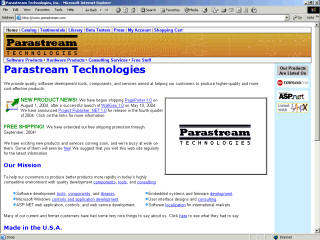 The public site for Parastream Technologies, Inc. (http://www.parastream.com)
is its main public presence, and serves pages for news, product and service literature,
and product ordering. It has secure sections using SSL with user authentication,
and allows controlled access to customer's account information, software
downloads and updates.
The public site for Parastream Technologies, Inc. (http://www.parastream.com)
is its main public presence, and serves pages for news, product and service literature,
and product ordering. It has secure sections using SSL with user authentication,
and allows controlled access to customer's account information, software
downloads and updates.
In the site, there are 100 FrontPage-generated HTML pages, 8 ASP pages, 8 web user controls, and 45 ASP.NET pages.
ADO.NET, C#, MS SQL
The following code is written in C# – web controls, database access classes, and all business logic classes. There are several server custom controls that are part of PagePorter, including a brand-new search engine for the site. The database runs on Microsoft SQL Server 2000, and accessed by stored procedures and the I/O classes using C# and ADO.NET. Over 12,000 lines of code and class library documentation.
ASP, ASP.NET, Visual Basic .NET
The ASP.NET web pages and web user controls are written in Visual Basic .NET. They include pages for secure download, display invoices, edit password, edit user information and preferences, login, logout, and the PagePorter Conversion Checker. 6,000 lines of code-behind (UI), and 500 lines of business logic code.
FrontPage
The entire site was developed using FrontPage 2003, and contains about 90 pages and 160 images. It uses the outline control in a couple of places (the Consulting Toolbox, for one) to make a collapsible outline. The Consulting Services page uses a modified third-party JavaScript called colorfade to run the banner at the top-right of the page.
Web Services
The site uses Parastream Technologies web services for some functions such as new password generation. Tilisoft's LocInfo web service is used to look up city, state, and county from a zip code for US addresses.
PayPal Integration
The web site implements the PayPal IPN to receive and process orders from Pay Now buttons, or the shopping cart.
The Future
The following activities are anticipated as development on the Parastream Technologies Internal Site progresses and the necessary web services and other infrastructures are put into place.
- Replacement of the shopping cart with out own implementation (it's currently hosted by PayPal) that will allow for more flexible pricing and delivery options, as well as real-time calculation of sales tax and shipping information using web services from third parties (such as FEDEX, UPS, and USPS) and our own (for sales tax)
- Development of a searchable on-line knowledge base of articles to provide better customer service for common problems.
- Possible implementation of a "live chat" facility on the site, either third party or our own implementation
Parastream Document Center Site
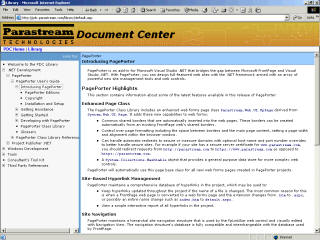 The
public site for the Parastream Document Center (http://pdc.parastream.com)
serves pages of product documentation and other reference material. There are
currently 1,100 document pages in the site.
The
public site for the Parastream Document Center (http://pdc.parastream.com)
serves pages of product documentation and other reference material. There are
currently 1,100 document pages in the site.
Parastream Technologies Internal Site
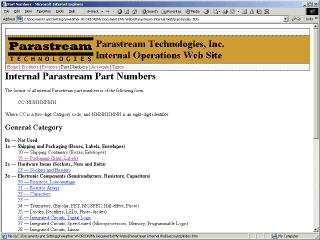 The internal site for Parastream Technologies, Inc. is used to manage all
aspects of the business, and is currently running on an internal intranet. Its
main function in life presently is to provide a place to store account
information, inventory, R&D plans, and other vital company information.
The internal site for Parastream Technologies, Inc. is used to manage all
aspects of the business, and is currently running on an internal intranet. Its
main function in life presently is to provide a place to store account
information, inventory, R&D plans, and other vital company information.
FrontPage
Currently, the entire site was developed on FrontPage 2003, and contains about 40 pages.
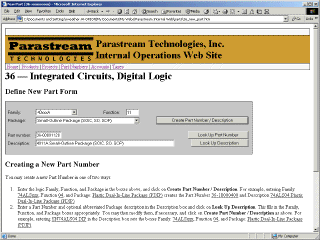 JavaScript
JavaScript
Some of Parastream's part numbering schemes are rather complex, so a JavaScript-driven form was developed to convert back and forth between industry-standard integrated circuit part numbers and Parastream's internal ones. It's completely stand-alone, and doesn't hook into the part numbers database yet. The script is about 175 lines of code.
MS SQL
Database tables and queries are currently under development (using Microsoft SQL Server 2000 Enterprise Manager) to manage Georgia sales tax rates per county, account information, transactions, and inventory. These databases are hosted by the web host for cost and performance reasons.
The Present and Future
The following activities are currently active, and in the queue for this year:
- Use PagePorter to port the current FrontPage-developed site to a Visual Studio .NET-developed site
- The site will be secured by SSL, have user authentication, and allow controlled access to the site
- Create a page to allow mass mailings to selected accounts and customers
- Create the web service for calculating sales tax
- Create a report for the Georgia Sales and Use Tax form
- Create the integrated web service to calculate shipping from multiple shipping vendors
Robert E. Weatherford Personal Site
This site (http://robert.weathergreen.com) is a very low priority at the moment, and for the foreseeable future. It's mainly a parking space and entry point for the Robert E. Weatherford Résumé Site. It also has a few pages about the vintage Korg BX-3 and CX-3 organs. Nothing is planned for this site over the next 12 months.
Robert E. Weatherford Résumé Site
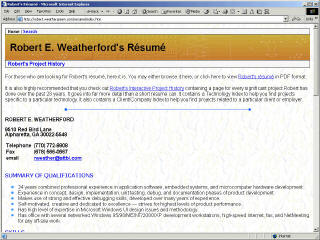 The Robert E. Weatherford Résumé Site (http://robert.weathergreen.com/resume)
is home to the on-line résumé, as well as the Interactive Project History.
The Robert E. Weatherford Résumé Site (http://robert.weathergreen.com/resume)
is home to the on-line résumé, as well as the Interactive Project History.
FrontPage
Currently, the entire site was developed on FrontPage 2003, and contains about 20 pages and 75 images. It uses the outline control in a few places to make a collapsible outline. There are no plans to port this site to another development platform, other than to switch to whatever search engine the Parastream Technologies Public Site will use so they may be searched together.
JavaScript and DHTML
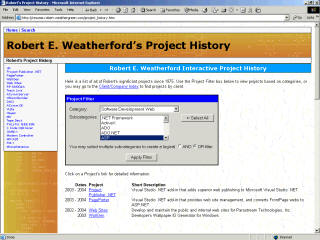 The
Interactive Project History page is the place where a visitor can look at a
complete list of projects over his career. It spans over 25 years and is quite
long. It's also fairly difficult to find specific information such as, "What has
he done with MFC?"
The
Interactive Project History page is the place where a visitor can look at a
complete list of projects over his career. It spans over 25 years and is quite
long. It's also fairly difficult to find specific information such as, "What has
he done with MFC?"
Client-side JavaScript and DTHML were used to provide a filter interface, where the visitor can apply filters to the project list to whittle it down to only the projects they're interested in. This method was chosen over a server-side interface for several reasons:
- The responsiveness of the filter is generally faster using the client-side implementation
- Browsers that aren't JavaScript compliant will see the entire project list, without having to be redirected to a separately-maintained list
- The project list can stay in an easy to maintain table
The filter was implemented in 200 lines of JavaScript code.
The Future
The following activities are in the queue:
- Test the JavaScript code under all IE and Netscape platforms